
 |
All reviews by RKF unless noted at the end. |
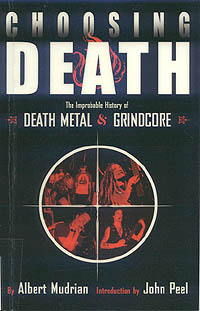 Feral House |
CHOOSING DEATH: THE IMPROBABLE HISTORY OF DEATH METAL & GRINDCORE By Albert Mudrian [Feral House] Don't be fooled by the subtitle: This is not really a comprehensive history of the death / grind scene (although at 283 pages, it's not exactly skimping on details, either). It would be more accurately described as a close examination of a handful of influential first-wave death metal and grindcore bands (Napalm Death, Repulsion, Godflesh, Morbid Angel, Deicide, Obituary, Carcass, Death, and more), beginning with their origins and continuing up to the present. Napalm Death, whose early demos and legendary first album SCUM were arguably the birth of UK grindcore, figure heavily in this book. It also concentrates heavily on Earache Records in the UK and Roadrunner Records in the US -- almost by default, given the bands being observed under the microscope here, most of whom were signed to one label or the other -- and offers an interesting and detailed look at the deal Earache cut with Columbia Records early in the 90s, an experiment in expansion that failed horribly for everybody involved and alienated most of Earache's roster, including Napalm Death and Godflesh, their two flagship bands. The writing is simple and uncluttered -- a good thing, given the confusion swirl of names and bands and players jumping from one band to the next while playing in three others on the side. A great deal of the book presents the actual musicians, label heads, A&R maggots, and other music industry people speaking about the scene in their own words, which is frequently quite illuminating (perhaps more illuminating than some might have wished for in some cases). The introduction by John Peel is largely disposable. So is the foreward by Nick Terry, the former editor of TERRORIZER. The book makes a nice companion to LORDS OF CHAOS, also from the same publisher. Even if you're seriously bumped-up on your death / grind history, chances are good you'll learn something new while reading this book (I did). Recommended, in spite of the peculiar faux-Xerox approach to the pictures (there are lots and lots of rare pictures of the bands, especially early in the scene's gestation). |
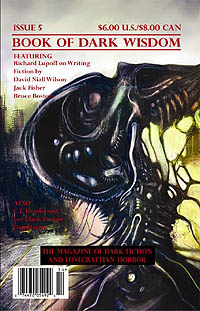 Dark Wisdom |
BOOK OF DARK WISDOM (# 4 and 5)
BOOK OF DARK WISDOM is a sleek, digest-sized magazine which bills itself as "The Magazine of Dark Fiction and Lovecraftian Horror." In this case there is truth in advertising. "Lovecraftian Horror" should come before "Dark Fiction" in the tagline, as most of the stories in both issues #4 and #5 reference or expand upon Lovecraft's Cthulhu Mythos. The quality of the stories varies quite a bit, with many of the pieces conforming to types, e.g. the "dark fiction" generally goes something like this -- character messes with things they don't understand, bad things happen; and for the Lovecraftian stories: character stumbles onto things he or she can't understand, bad things happen, usually involving tentacles, many mouths and much slime. Granted, much of this comes with the territory and is to be expected. The strongest stories in both issues play against or play off these formulas. In issue #4, C.J. Henderson's "The Incident on Highway 19" and Stanley C. Sargent's "The Hoppwood Tenant" are the stars of the issue. While both are firmly in the Mythos tradition, the authors infuse their stories with enough personality to grab the reader's attention. The stories to look out for in issue #5 are Jack Fisher's creepy urban folktale "Boogedy" and Bruce Boston's SF-flavoured "The Final Fragrance." Along with fiction, BOOK OF DARK WISDOM publishes poetry, which is so not my thing that I don't feel qualified to comment on it, and non-fiction. Issue #4 contains an interesting Fortean Times type article on Sedna and the Exploding Planet Hypothesis. Issue #5 also contains the first installment of a series of columns on writing by old-school SF writer Richar A. Lupoff. The piece in Issue #5 traces one of Lupoff's stories, "The Incident of the Impecunious Chevalier" (which brings together Doyle's Sherlock Holmes and Poe's Inspector Dupin), from genesis to publication and is something that should be of particular interest to beginning writers. Both issues also contain extensive and well-done reviews sections. The reviews cover a wide range of media with the print reviews paying particular attention to the small press (always a good thing.) [N/A] |
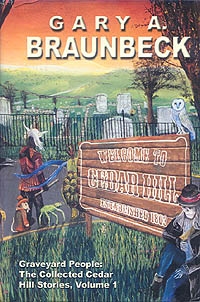 Earthling Publications |
GRAVEYARD PEOPLE: THE COLLECTED CEDAR HILL STORIES, VOL. 1 By Gary A. Braunbeck [Earthling Publications] Look for this one in the next issue. Sorry about that. Yes, I know I suck. Big-boned dominatrixes should be given free reign to tie me down and abuse me severely. It really, truly will be in the next issue, now that it's the only book left from a pile that has been steadily whittled down. Really. The next issue. Believe it. |
 Regan Books |
THE OTHER HOLLYWOOD: THE UNCENSORED ORAL HISTORY OF THE PORN FILM INDUSTRY By Legs McNeil & Jennifer Osborne [Regan Books] Remember Legs McNeil? PUNK magazine, the 70s NYC punk scene, PLEASE KILL ME? Yeah, that guy. Well, he's back (with co-writer Jennifer Osborne), and this book does for the Hollywood porn industry what PLEASE KILL ME did for the punk scene. The book's scope spans the age of "nudie cuties" (stag films, nudist films, etc.) during the 50s to the first major outbreak of AIDS in the porn industry in 1998, but the vast majority of the book's focus is concentrated on the 70s and 80s, the era in which DEEP THROAT's amazing success pushed porn out of the adult bookstores and into the mainstream, at which point the dawn of home video caused the porn business to absolutely explode in the 80s. As with PLEASE KILL ME, the book's format consists of interviews with pretty much everybody who's anybody in the porn biz, which makes things really interesting, far more so than a more academic tome charting the rise of Hollywood porn. Given McNeil's endless fascination with crime, drugs, and violence, you will not be at all surprised to learn that there's plenty of that in here, including details on the Mafia's role in porn, the allegations that Linda Lovelace was forced to participate in making films (including a notorious bestiality loop that she later completely denied having ever done, in spite of ample evidence to the contrary), John Holmes and his involvement in the Wonderland slayings, the Traci Lords scandal, and a whole lot more. The book is 620 pages long and full of sordid and surprising revelations all the way through, which makes it a highly entertaining read. If you ever wondered how accurate BOOGIE NIGHTS or WONDERLAND or Linda Lovelace's ORDEAL were, now's your chance to find out, straight from the mouths of all the people involved. A truly great book, and one that's high on DEAD ANGEL's list of recommended reading. |
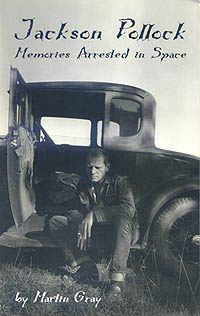 Santa Monica Press |
JACKSON POLLOCK: MEMORIES ARRESTED IN SPACE By Martin Gray [Santa Monica Press] It's taken me entirely too long to get around to reviewing this, but it was worth the wait, trust me. If Martin Gray's name rings a bell, it's because I reviewed his book on Charlie Parker, BLUES FOR BIRD, a biography of jazz great Charlie Parker written entirely in poetic verse. This book is very much in that vein, written in iambic trimeter (bonus points if you actually know what that means) and covering the life and art of possessed country bumpkin turned painter Jackson Pollock. Martin spent a great deal of time researching Pollock's life and art history, and here he has done an excellent job of paring the events of 44 years down to 206 pages of verse (there's also a six-page glossary at the end for those unfamiliar with the art jargon sprinkled through the verses). Pollock, for all his many faults, is considered by many to be one of the the major artists of the 20th century (along with Pablo Picasso, a major influence on his work), and his technique of dripping / splashing paint on canvases rather than applying them by brush was a radical notion in the 1940s. At the same time, he was a deeply disturbed man, conflicted about his sexuality and so alienated that he had difficulty dealing with people in general; he was also an alcoholic prone to fits of violence, stupidity, and reckless driving (which is what killed him in the end, when he ran into a tree while driving drunk). Martin does a fine job of capturing all of these elements in a simple and understated way, making this a compelling biography that's probably much easier to read and digest than most ponderous art tomes devoted to Pollock. I think I actually prefer this method of writing about musicians and artists, actually. But what will Gray do now for an encore? (I'm kind of hoping for an epic recounting of the life and history of Wagner, myself.) |
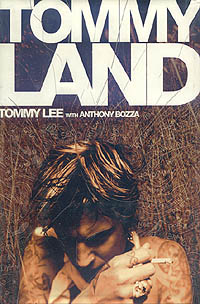 Atria Books |
TOMMYLAND By Tommy Lee (with Anthony Bozza) [Atria Books] Tommy Lee, as you know (unless you've been living in a cave for the past twenty years), is the drummer for Motley Crue, possibly the most consistently entertaining (if not always exactly good) band to emerge from the 80s wave of glam and hair-metal bands. While Tommy's just as infamous for being a fuckup as he is for his big drumstick, he's also a highly amusing guy, and his book -- written by him with help from Anthony Bozza, who has written a couple of other rock-dude "autobiographies" (including one by Eminem) -- is surprisingly lucid and intelligent for a guy who's probably literally snorted my weight in cocaine over the past two decades. It's also fairly irreverent (his big drumstick has "speaking parts" all throughout the book, and the book is peppered with reproduced conversations between Tommy and his eternally perplexed British publisher regarding certain hilarious but unfathomably American scenes), and to his credit, Tommy does not blink or hide in the bushes when it comes to discussing topics like his extremely physical falling-out with Vince Neil (the fat, drunken "singer" for Motley Crue, who hasn't exactly looked or sounded good for quite some time now), the trials and tribulations of living with Pamela Lee Anderson, getting locked up, drugs, and of course, many charming tales of luridly excessive behavior during his tenure in the Crue. He does waste a bit of time talking about Methods of Mayhem, the rap-heavy band he formed after leaving the Crue (he's still doing it now, although it's probably on ice until he finishes this Crue reunion tour), which is too bad, since Methods of Mayhem is -- sorry, Tommy -- kind of a mediocre band, but for the most part all the talk is about exciting, lurid, rock 'n roll shit, so we'll forgive him for a bit of pimping, hmm? If you read the Motley Crue bio THE DIRT, in which the band let it all hang out, then you have an idea of what's happening here, and this will be right up your alley. I'm sure that Nikki Sixx's autobiography, due out any minute now supposedly, will be every bit as entertaining.... |